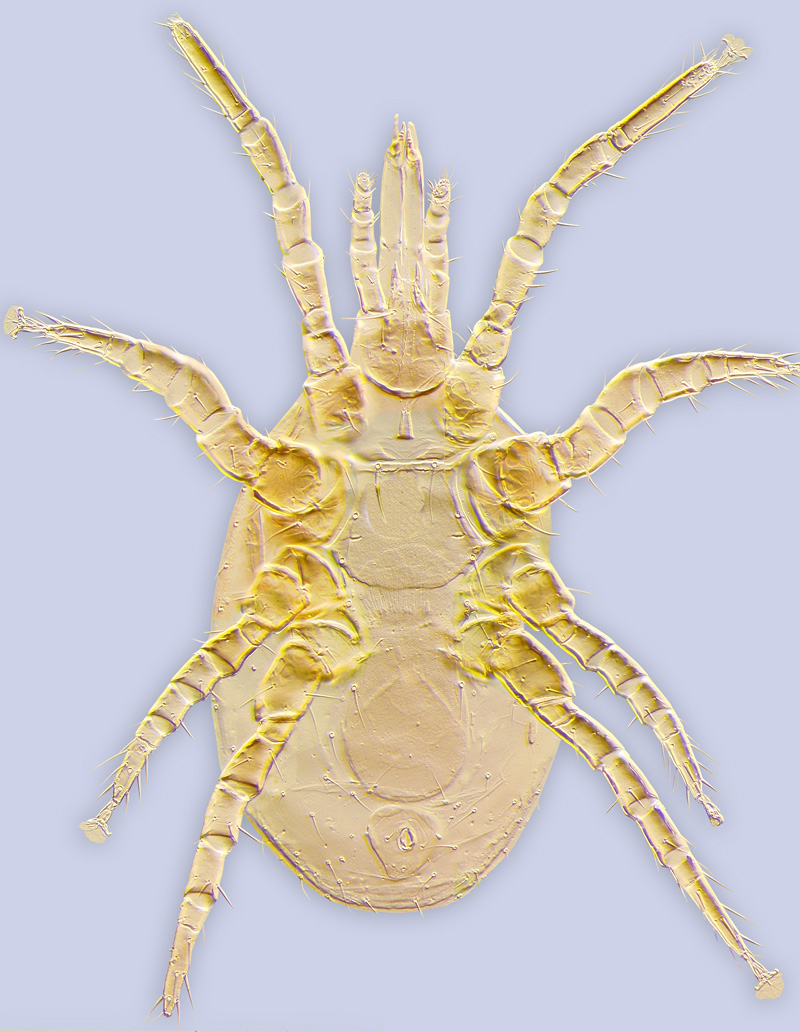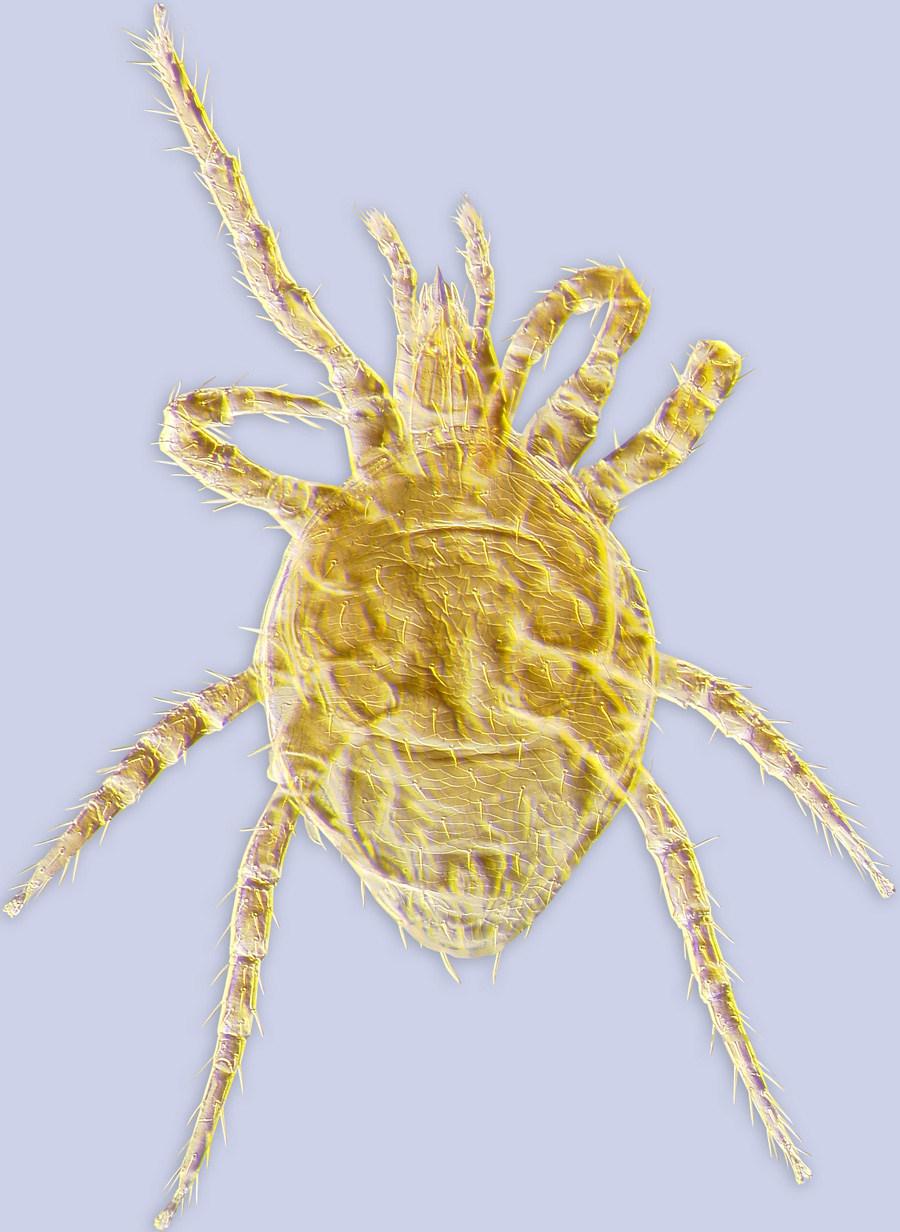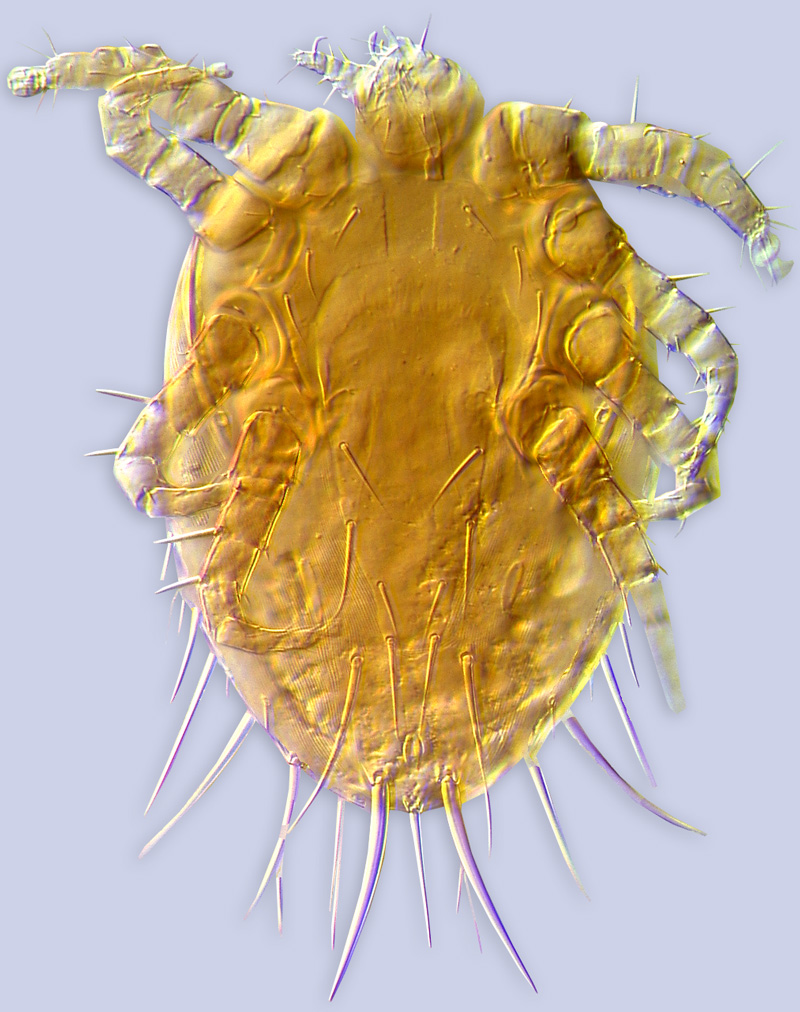Bee Mites : Acari : Parasitiformes : Mesostigmata
Family Laelapidae Berlese, 1892
Type genus Laelaps Koch, 1836
Material (show database records).
General Description. This family is the most morphologically and ecologically diverse group of Mesostigmata. Thirty-five genera of laelapids have developed ectoparasitic associations with mammals; 10 genera are free-living predators in soil; 43 genera include species associated with arthropods: Coleoptera (8 mite genera), Blattaria (2), Isoptera (1), Hymenoptera (21), Araneae (1), Myriapoda (7) and terrestrial Crustacea (2) (Casanueva, 1993). Ecology of bee-associated mites is poorly known. Mites of the genus Neohypoaspis are predators on astigmatid mites in nests of stingless bees (Delfinado-Baker et al., 1983). Species of the genus Pneumolaelaps feed on pollen and nectar in nests of bumblebees (Royce and Krantz, 1989). Melittiphis alvearius is a scavenger on pollen in colonies of the European honeybee (Gibbins and Toor, 1990). Mites of the genera Varroa, Euvarroa,Tropilaelaps are obligatory parasites of different species of Apis, inflicting significant damage to apiculture (Eickwort, 1988).
Genera associated with bees
- Androlaelaps Berlese, 1903 (normally is associated with rodents, but routinely occurs in the nests of bumblebees and in beehives)
- Bisternalis Hunter, 1963
- Cosmolaelaps Berlese, 1903
- Dinogamasus Kramer, 1898
- Eumellitiphis Turk, 1948
- Euvarroa Euvarroa Delfinado et Baker, 1974
- Hunteria Delfinado-Baker, Baker et Flechtmann, 1984
- Hypoaspis Canestrini, 1884 (Probably paraphyletic genus with unclear boundaries. We include here Hypoaspis lubrica Voigts et Oudemans and Hypoaspis meliponarum Vitzthum)
- Laelaps Koch, 1836
- Laelaspoides Eickwort, 1966
- Meliponaspis Vitzthum, 1930
- Melittiphis Berlese, 1918
- Melittiphisoides Delfinado-Baker, Baker et Flechtmann, 1984
- Neohypoaspis Delfinado-Baker, Baker et Roubik, 1983
- Pneumolaelaps Berlese, 1920
- Raymentia Womersley, 1956
- Stevelus Hunter, 1963
- Stigmatolaelaps Krantz, 1998
- Stratiolaelaps Berlese, 1916
- Tropilaelaps Delfinado et Baker, 1961
- Urozercon Berlese, 1902
- Varroa Oudemans, 1904
- Xylocolaelaps Royce et Krantz, 2003
- Zontia Turk, 1948
(Berlese and Leonardi, 1902; Casanueva, 1993; Davydova and Bogatyrev, 1990; Davydova et al., 1987; Delfinado and Baker, 1961; Delfinado-Baker et al., 1983; Delfinado and Baker, 1974; Delfinado-Baker et al., 1984; Eickwort, 1966; Evans and Till, 1966; Hunter and Husband, 1973; Hunter, 1963; Krantz, 1998; Lindqvist, 1998; Royce and Krantz, 2003; Salt, 1929; Sumangala and Haq 2001; Turk, 1948; Vitzthum, 1930; our data)
Identification. See key to bee-associated mite families here.
Distribution (show map).
Key to genera of the family Laelapidae found on bees or their nests in the New World
(important Old World pest, Tropilaelaps, is also included)
adults |
| 1. | Female: Sternal and metasternal shields fused; metasternal shields reaching posterior level of coxae IV; sternal shield with porose area at level of coxae III. Legs III-IV massive, distinctly wider than legs I; femora III-IV with dorsal cuticular spur. Posterior ventrum, including legs III-IV, with spiniform or widened setae. Associated with stingless bees (Meliponini) | |
|
- | Female: Sternal and metasternal shields free or fused; metasternal shields not reaching posterior level of coxae IV; sternal shield without porose area at level of coxae III. Legs III-IV not distinctly wider than legs I; femora III-IV without dorsal cuticular spur | |
|
2(1) | Presternal shield present, single. Presternal and sternal shields remote; setae st1 situated on presternal shield, about half of distance st1-st2. Posterior part of sternal shield wider posteriorly than anteriorly, bearing setae st2-3; Posterior margin of epigynial shield near anal shield. Anal shield elongated, somewhat pentagonal. Associated with stingless bees (Meliponini) | |
|
- | Presternal shield, absent, indistinct, or fused with sternal shield; if distinct than paired and situated near sternal shield; sternal seta st1 distinctly longer than half of st1-st2 distance, if shorter then situated on sternal shield. Position of posterior margin of epigynial shield and shape of anal shield variable | |
|
3(2) | Anal shield with 5 long and stout setae. Movable and fixed digit of chelicera without denticles, represented by long hyaline lobes. Sternal setae st4 of female not developed, represented by alveoli. Female with ventogenital shield bearing 4 pairs of setae. Corniculi reaching about half of palp femur. Holodorsal shield hypertrichous. Found in nests of termites (Isoptera) and apid bees constructing nests in termitaria (Meliponini and Centridini) | |
|
- | Anal shield with 3 setae that usually not distinctly stouter than other ventral setae. Movable and fixed digit (if present) of chelicera dentate or edentate, well sclerotized. Sternal setae st4 of female filiform. Female usually with epigynial shield bearing 2 pairs of setae. Corniculi usually longer. Holodorsal shield orthotrichous or hypertrichous | |
|
4(3) | Two pairs of hypostomal setae. Female: Peritemes looped terminally, confined to level of coxae III; metopodal and genitoventral shields large, hypertichous, covering almost all opisthogaster. Parasites of Apis | |
|
- | Three pairs of hypostomal setae. Female: Peritremes, if present, not looped and usually reaching coxae II; metopodal and genitoventral (if present) shields otherwise | |
|
5(4) | Setae j1, some marginal setae of idiosoma and legs distinctly wider than others, with rounded or spatulate ends. Anal shield large | |
|
- | Width of idiosomal setae not distinctly different, spatulate setae absent, if present, all uniform. Anal shield variable | |
|
6(5) | Epigynal shield not enlarged. Distance between epigynal and anal shields large (shields distinctly separated from each other). Genitoventral and anal shield of male separate. Associated with stingless bees (Meliponini) | |
|
- | Epigynal shield enlarged. Distance between epigynal and anal shields small (shields nearly touching each other). Genitoventral and anal shield of male fused. Associated with stingless bees (Meliponini) | |
|
7(5) | Each row of hypognathal groove with one denticle. Anal shield of female and ventroanal shield of male with posteriorly directed cuticular spur. Presternal region of female with keel-like ridge. Male spermatodactyl thin and long, as long as chelicera. Pollenophagous, in beehives. | |
|
- | At least several rows of hypognathal groove with more than one denticle. Anal shield of female and ventroanal shield of male without cuticular spur. Presternal region of female with without keel-like ridge (presternal shields may be present). Male spermatodactyl variable | |
|
8(7) | Female: Sternal shield deeply (at least half of shield length) concave posteriorly. 2-3 posterior rows of hypognathal groove with only one denticle. Anal shield wider than posterior margin of ventrogenital shield | |
|
- | Female: Sternal shield truncate, convex, or slightly concave (less than half of shield length) posteriorly; 2-3 posterior rows of hypognathal groove with more than one denticle. Anal shield usually narrower than posterior margin of ventrogenital shield | |
|
9(8) | Female: Metasternal and sternal shields fused. Setae st1 more than 2 times shorter than setae st3-st4. Epigynial shield widened posteriorly, truncate. Associated with stingless bees (Meliponini) | |
|
- | Female: Metasternal shield free. Setae st1 nearly equal to setae st3-st4. Epigynial narrowed posteriorly, with rounded, pointed, or bilobe posterior edge. Associated with stingless bees (Meliponini) | |
|
10(8) | Female: Sternal shield between coxae I-II strongly widened: lateral margins straight, almost parallel. Sternal setae st1 about 3 times shorter than distance st1-st2. Sternal setae st4 situated on soft cuticle near metasternal shields. Chelicera with long process (exceeding length of movable digit) at base of movable digit, and another smaller lateral process (also present in male). Associated with stingless bees (Meliponini) | |
|
- | Female: Sternal shield between coxae I-II not widened, if widened then margins pointed. Sternal setae st1 longer than half of distance st1-st2. Sternal setae st4 situated on metasternal shields or on soft cuticle. Chelicera without processes | |
|
11(10) | Apotele 1-tined. Dorsum and opisthogaster hypertrichous. Anterior part of movable digit of male chelicera filiform, long (longer than subcapitulum). Parasites of Apis | |
|
- | Apotele 2- or 3-tined. Dorsum and opisthogaster orthotrichous or hypertrichous. Movable digit of male chelicera not filiform (unknown for Stevelus) | |
|
12(11) | Female: Holodorsal shield covers about 2/3 of dorsum. Corniculi short, slightly protruding half of palp femur. Subcapitulum placed ventrally, not visible from above. Fixed and movable digits chelicera without teeth, short, almost trianglular dorsally. Anterior end of peritremes at level of anterior edge of coxae II. Associated with stingless bees (Meliponini) | |
|
- | Female: Holodorsal shield covers all dorsum. Corniculi longer, reaching at least level of palp tibia. Subcapitulum placed visible dorsally. Fixed and movable digits of female chelicera dentate, elongate. Length of peritremes variable | |
|
13(12) | Terminal part of movable and fixed digits of chelicera long, protruding opposite digit. Genu IV with 11 setae. Anterior end of peritremes at level of middle of coxae II. Associated with Augochlorini (Halictidae)| near Raymentia (ex Caenoaugochlora) |
| |
|
- | Terminal part of movable and fixed digits of chelicera shorter, not protruding opposite digit. Genu IV with 9-10 setae. Anterior end of peritremes at least at posterior level of coxae I | |
|
14(13) | Pilus dentilis well developed, often with inflated basal part. Fixed and movable digits of male chelicera without teeth. Nests of mammals and rodents, occasionally in beehives and nests of Bombus | |
|
- | Pilus dentilis weakly developed, setiform. At least movable digits of male chelicera with teeth | |
|
15(14) | Dorsal setae spatulate, cuneiform, or scimitar-like. Free-living, can occur in bee-hives | |
|
- | Dorsal setae simple or pilose, never markedly flattened | |
|
16(15) | Genu IV with 10 setae, 2 setae ventral. Peritremes usually broad. Opisthogaster usually hypertrichous. Associated with Bombus, can be found in beehives | |
|
- | Genu IV with 9-10 setae, 1 seta venral (if 2 then peritremes narrow). Peritremes narrow. Opisthogaster usually not densily setose | |
|
17(16) | Ventroanal shield of male absent, anal shield free. At least some posterior idiosomal setae pilose. Presternal shields of female fused with sternal shield; anterior margin of sternal shield not straight and not uniformly sclerotized. Anal shield of female rounded, never triangular and with straight anterior margin. Associated with Augochlorini (Halictidae) | |
|
- | Ventroanal shield of male present, incorporates anal shield. Idiosomal setae smooth. Presternal shields of female not fused with sternal shield; anterior margin of sternal shield straight or almost straight, uniformly sclerotized. Anal shield of female rounded or triangular with straight anterior margin. Free-living, occasionally in bee hives, some associated with stingless bees.
| Hypoaspis sensu Evans and Till (1979) |
|
|
References
Berlese, A. & G. Leonardi. 1902. Acari sud americani. Zoologischer Anzeiger.25: 12-18.
Casanueva, M. E. 1993. Phylogenetic studies of the free-living and arthropod associated Laelapidae (Acari: Mesostigmata). Gayana Zoologia.57: 21-46.
Davydova, M. S. & N. R. Bogatyrev. 1990. [The fauna and several peculiarities of ecology of gamasid mites associated with bumblebees]. In Chlenistonogie i gelminty [=Arthropods and helminths], ed. G. S. Zolotarenko, 27-33. Novosibirsk: Nauka.
Davydova, M. S., V. V. Nikolsky & N. R. Bogatyrev. 1987. Gamasid mites associated with bumblebees on the territory of Western Siberia. In Problemy pochvennoi zoologii. Materialy dokladov IX Vsesoyuznogo soveshchaniya. [Problems of soil zoology. Reports from the 9th All Union Conference] ed. B. E. Kurashvili, 79-80. Tbilisi: Metsniereba.
Delfinado, M. D. & E. T. Baker. 1961. Tropilaelaps, a new genus of mite from the Philippines (Laelapidae [s.lat.]: Acarina). Fieldiana Zoology.44: 53-56.
Delfinado, M. D. & E. W. Baker. 1974. Varroidae: A new family of mites on honeybees (Mesostigmata: Acarina). Journal of Washington Academy of Sciences.64: 4-10.
Delfinado-Baker, M., E. W. Baker & C. H. W. Flechtmann. 1984. Acari domum meliponinarum brasiliensium habitantes. V. Two new genera and species of Laelapidae (Mesostigmata: Acari) from stingless bee nests. International Journal of Acarology.10: 3-10.
Delfinado-Baker, M., E. W. Baker & D. W. Roubik. 1983. A new genus and species of Hypoaspidinae (Acari: Laelapidae) from nests of stingless bees. International Journal of Acarology.9: 195-203.
Eickwort, G. C. 1966. A new genus and species of mite associated with the green bee Augochlorella (Hymenoptera: Halictidae) in Kansas (Acarina: Laelaptidae: Hypoaspidinae). Journal of the Kansas Entomological Society.39: 410-429.
Eickwort, G. C. 1988. The origins of mites associated with honey bees. In Africanized honey bees and bee mites, eds. G. R. Needham, R. E. Page, M. Delfinado-Baker & C. E. Bowman, 327-338. Chichester: Ellis Horwood.
Evans, G. O. & W. M. Till. 1966. Studies on the British Dermanyssidae (Acari: Mesostigmata) Part II Classification. Bulletin of the British Museum (Natural History) Zoology.14: 8-370.
Gibbins, B. L. & R. F. Vantoor. 1990. Investigation of the parasitic status of Melittiphis alvearius (Berlese) on honeybees, Apis mellifera L, by immunoassay. Journal of Apicultural Research.29: 46-52.
Hunter, P. E. 1963. Two genera of mites associated with stingless bees (Acarina: Laelaptidae). Acarologia.5: 5-12.
Hunter, P. E. & R. W. Husband. 1973. Pneumolaelaps (Acarina: Laelapidae) mites from North America and Greenland. Florida Entomologist.56: 77-91.
Krantz, G. W. 1998. A new genus and two new species of hypoaspidine mites (Acari: Laelapidae) associated with old world carpenter bees of the tribe Xylocopini (Hymenoptera: Apidae: Xylocopa). International Journal of Acarology.24: 291-300.
Lindqvist, L. 1998. Taxonomic revision of the genus Dinogamasus Kramer (Acari: Mesostigmata: Laelapidae). Entomologica Scandinavica.54: 1-109.
Royce, L. A. & G. W. Krantz. 1989. Observations on pollen processing by Pneumolaelaps longanalis (Acari, Laelapidae), a mite associate of bumblebees. Experimental & Applied Acarology.7: 161-165.
Royce, L. A. & G. W. Krantz. 2003. A new genus and species of hypoaspidine mite (Acari : Laelapidae) associated with a night-flying xylocopinine carpenter bee (Hymenoptera : Apidae : Xylocopa) in Thailand. International Journal of Acarology.29: 107-111.
Salt, G. 1929. A contribution to the ethology of the Meliponinae. Transactions of the Entomological Society of London.77: 431-468+29 Plates.
Sumangala, K. & M. A. Haq. 2001. Survey of the mite fauna associated with Apis spp. in Kerala, southern India. In Acarology: Proceedings of the 10th International Congress., eds. R. B. Halliday, D. E. Walter, H. C. Proctor, R. A. Norton & M. J. Colloff, 565-568. Melbourne: CSIRO Publishing.
Turk, F. A. 1948. Insecticolous Acari from Trinidad, B.W.I. Proceedings of the Zoological Society of London.118: 82-125.
Vitzthum, H. 1930. Acarologische Beobachtungen. (14 Reihe.). Zoologische Jahrbücher. Abteilung für Systematik, Geographie und Biologie der Tiere.59: 281-350.
Walter, D. E., J. J. Beard, K. L. Walker & K. Sparks. 2002. Of mites and bees: A review of mite-bee associations in Australia and a revision of Raymentia Womersley (Acari : Mesostigmata : Laelapidae), with the description of two new species of mites from Lasioglossum (Parasphecodes) spp. (Hymenoptera : Halictidae). Australian Journal of Entomology.41: 128-148.
Image Gallery
B. OConnor and P. Klimov ©
Created: April 18, 2012
Last modified: 




